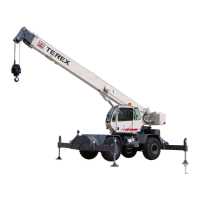Crane Boom
WEEKLY:
STRUCTURAL MEMBERS AND WELDS Visually inspect all structural members and welds
including (but not limited to) the extended boom for straightness, roller (or pad) adjustment,
and cracks. Pay special attention to the longitudinal welds joining the top, side and bottom
plates. Check the welds attaching the jib ears to the boom head and the welds attaching
the boom head to the tip section. Inspect the cylinder attaching supports and the boom
pivot area.
On the superstructure, inspect the superstructure as well as the welds on the hoist cylinder
supports and the welds between the bottom mounting plate and the vertical plates. This is
especially important if the machine is being used extensively in clamshell, pile driving,
concrete pouring, headache ball, or other high duty cycle applications.
On the carrier, inspect the swing bearing weld band and supporting header welds. Check
the outrigger attaching welds, outrigger box ends at the collar, jack cylinder mounting tube,
and the beam welds.
BOOM Visually inspect all boom sections a minimum of weekly or every fifty (50) hours,
whichever occurs first. Preparatory to making the inspection, set the outriggers and rotate
the upper to an area where the boom can be fully lowered and extended.
With the boom fully lowered and extended, visually inspect the sides, top and bottom of
each section for any unusual deformation, scrubbing, wear, or cracking in either the plates
or welds, particularly the fillet welds along the bottom edge of the side plates of the
telescoping sections. In addition, note any missing or illegible indicator mark decals on the
telescoping sections.
If any cracks in either fillet welds or plates are noted, the particular component
must be replaced before any further crane operations are performed. This is
necessary to maintain the structural strength of the boom and prevent possible
catastrophic failure resulting in injury or property damage.
Field repair of boom sections is NOT recommended because distortion may be introduced
and original structural strength not restored.
Boom extension indicator decals are extremely important and must be maintained in place
at all times. Boom section failures can occur due to overstressing within rated capacities if
the sections are not equally extended within one indicator mark difference between the
telescoping sections.
NOTE: Sections are equalized by fully extending or fully retracting the boom. When
the boom reaches either full extension or retraction continuing to hold the telescope
lever in the extended or retracted position will allow the boom sections to be
proportioned equally.
Inspection
84 P/N 12261-319 REVISED: August 2012
Courtesy of Crane.Market

